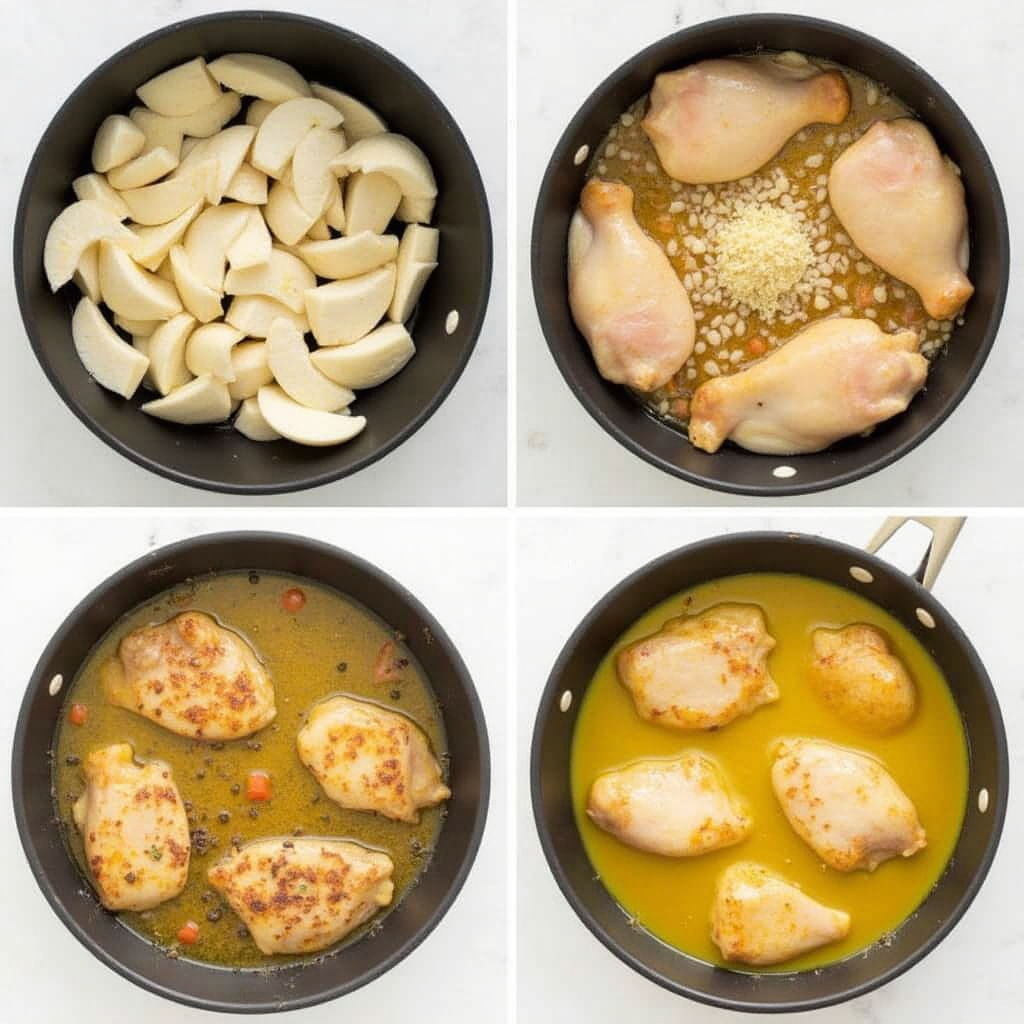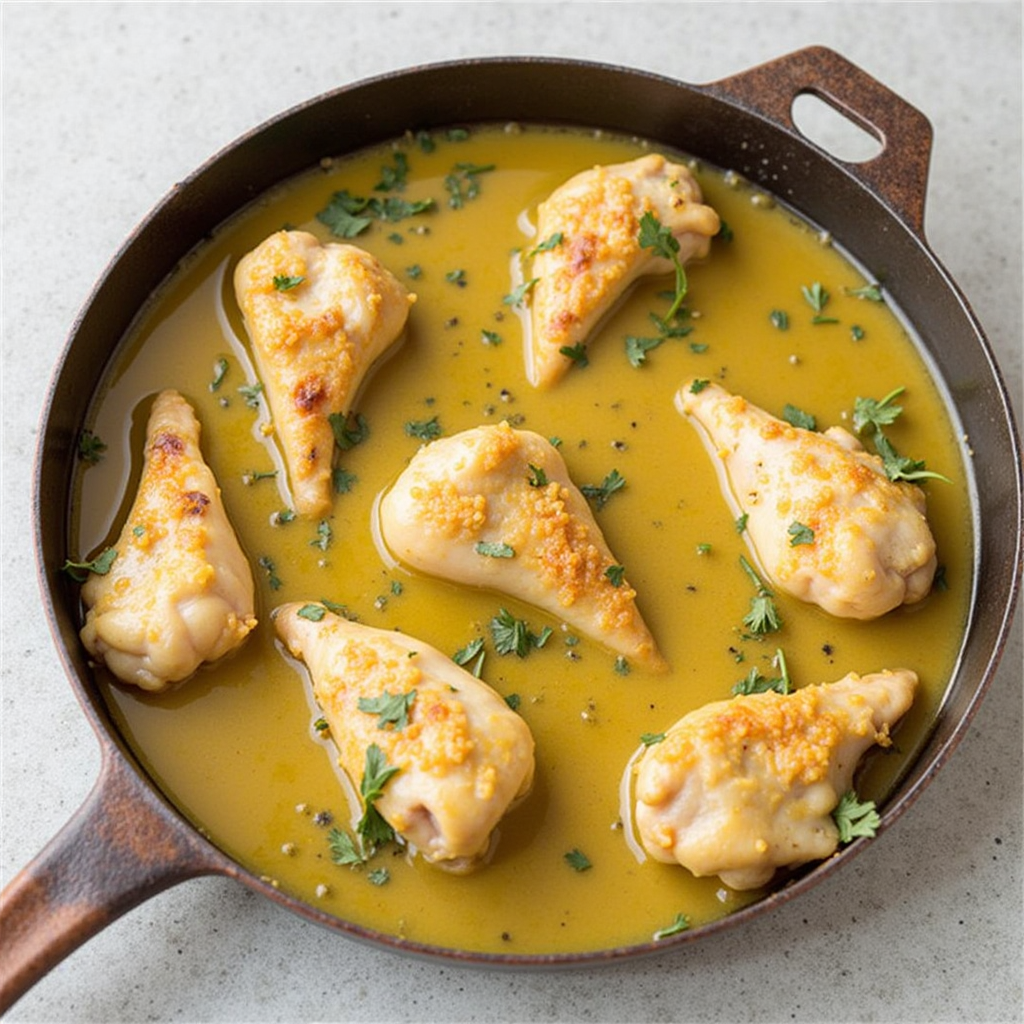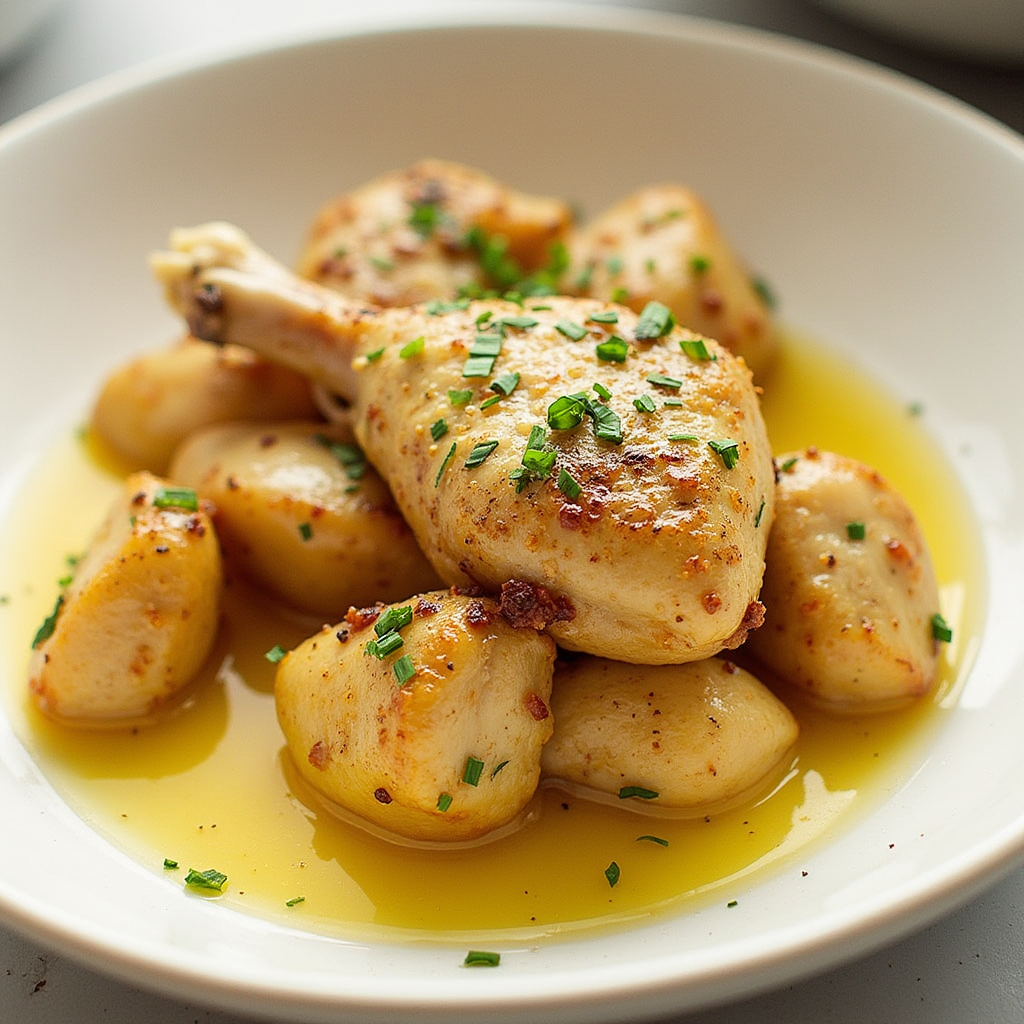Few dishes achieve the rich, succulent texture of a well-prepared chicken confit recipe. This classic French dish, traditionally cooked in its own fat, delivers unparalleled tenderness and depth of flavor. By using a slow-cooking technique, the meat absorbs the infused flavors of aromatic herbs and seasonings, creating an indulgent dining experience.
Home cooks and chefs alike appreciate the chicken confit recipe for its versatility. It can be served as a main course, incorporated into salads, or even used as a flavorful filling in sandwiches. The dish also boasts a remarkable shelf life, allowing for convenient meal preparation.
Mastering this technique requires patience, but the result is rewarding. From selecting the best ingredients to slow-cooking at the perfect temperature, each step contributes to an extraordinary dish. This guide provides a detailed breakdown of the process, ensuring that you achieve restaurant-quality chicken confit recipe in your own kitchen.
The History and Origins of Chicken Confit
The chicken confit recipe is deeply rooted in French culinary traditions, originating as a preservation method before refrigeration existed. “Confit” comes from the French word confire, meaning “to preserve.” This technique was historically used to extend the shelf life of meats, particularly in the Gascony region.
Traditionally, confit involved slow-cooking duck or goose in its own fat and storing it in sealed containers. Over time, this method expanded to include poultry like chicken confit recipe, as well as vegetables and even fruits. The process not only preserved food but also intensified its flavors, making it a sought-after delicacy.
French chefs popularized chicken confit recipe in fine dining, elevating it from a necessity to a gourmet dish. Today, it remains a staple in French bistros and modern kitchens, proving that centuries-old techniques still have a place in contemporary cuisine.
Why Chicken Confit is a Culinary Delight
A well-executed chicken confit recipe delivers a level of tenderness that few cooking methods can replicate. The slow-cooking process allows the meat to retain moisture while becoming incredibly soft, almost melting in the mouth.
Beyond its texture, the depth of flavor sets chicken confit recipe apart. The prolonged exposure to aromatic herbs, spices, and rendered fat infuses the meat with an unparalleled richness. This technique results in a dish that is not only delicious on its own but also enhances other recipes when incorporated into salads, pasta, or sandwiches.
Additionally, the longevity of chicken confit recipe makes it practical for meal planning. Properly stored, it can last for weeks, ready to be crisped up and served at a moment’s notice. These characteristics make chicken confit recipe an essential addition to any gourmet kitchen.
Essential Ingredients for Chicken Confit
Crafting an exceptional chicken confit recipe requires selecting high-quality ingredients. Every component plays a crucial role in enhancing the dish’s taste and texture.
Key Ingredients:
- Chicken thighs or legs: These cuts contain more fat, making them ideal for slow cooking.
- Duck fat or rendered poultry fat: Ensures proper cooking while adding depth to the flavor.
- Salt: Used for curing the meat and intensifying taste.
- Garlic cloves: Infuses the dish with a subtle, earthy aroma.
- Fresh thyme and rosemary: Provide herbaceous notes that complement the richness.
- Black peppercorns: Adds a mild heat and complexity.
By carefully selecting these ingredients, you guarantee that your chicken confit recipe delivers both flavor and tenderness with every bite.
Step-by-Step Guide to Making Chicken Confit

Preparing a perfect chicken confit recipe requires patience, but the process is straightforward. Following these steps will ensure optimal results.
- Curing the Chicken: Generously season the chicken pieces with salt, garlic, thyme, rosemary, and black pepper. Let them rest in the refrigerator for 12-24 hours to enhance flavor.
- Rinsing and Drying: After curing, rinse off excess salt and pat the meat dry. This step prevents the dish from becoming overly salty.
- Slow-Cooking in Fat: Arrange the chicken in a deep pan, fully submerge in fat, and cook at a low temperature (200°F or 93°C) for 3-4 hours.
- Cooling and Storing: Once tender, allow the meat to cool in the fat before transferring it to storage containers.
Each step contributes to the unique qualities that make a chicken confit recipe so special.
Choosing the Right Fat for Confit Cooking
The type of fat used in a chicken confit recipe significantly affects the final result. Traditionally, duck fat is preferred due to its rich, silky texture and ability to complement poultry. However, other fats can also be used, depending on availability and preference.
Best Options for Confit Cooking:
- Duck fat: Offers a luxurious mouthfeel and classic flavor.
- Chicken fat (schmaltz): Enhances the natural taste of the meat.
- Olive oil: A lighter alternative with a distinct Mediterranean touch.
- Lard: Provides a more neutral taste while preserving the meat effectively.
Selecting the right fat ensures that your chicken confit recipe remains authentic while achieving maximum tenderness and taste.
Best Seasonings and Herbs for Maximum Flavor
Seasonings are integral to creating a well-balanced chicken confit recipe. Choosing the right combination enhances both the aroma and taste.
Recommended Seasonings:
- Coarse salt: Essential for the curing process and drawing out moisture.
- Crushed garlic: Imparts a robust, savory depth.
- Thyme and rosemary: Classic herbs that complement poultry beautifully.
- Bay leaves: Introduces subtle earthiness.
- Black peppercorns: Adds mild heat without overpowering other flavors.
Each seasoning plays a role in elevating the overall profile of your chicken confit recipe, ensuring an unforgettable culinary experience.
The Slow-Cooking Process: Achieving Perfect Texture
The hallmark of an outstanding chicken confit recipe lies in its slow-cooking process. By maintaining a low temperature, the meat slowly absorbs fat, resulting in its signature fall-off-the-bone texture.
Tips for Optimal Cooking:
- Keep the temperature steady at 200°F (93°C).
- Ensure the chicken is fully submerged in fat to prevent drying out.
- Allow ample cooking time (3-4 hours) to achieve peak tenderness.
Patience is key when preparing a chicken confit recipe. The slow infusion of flavors makes all the difference.
How to Store and Preserve Chicken Confit
Proper storage is essential for maintaining the integrity of a chicken confit recipe. When stored correctly, the dish can last for several weeks without losing its rich flavors.
Storage Methods:
- Keep the meat submerged in fat in an airtight container.
- Refrigerate for up to one month for optimal freshness.
- For long-term preservation, freeze for up to three months.
These techniques ensure that your chicken confit recipe remains delicious whenever you’re ready to enjoy it.
Reheating and Serving Chicken Confit Like a Pro
Bringing a chicken confit recipe back to life requires careful reheating. A crisp exterior combined with a tender interior ensures the best experience.
Reheating Tips:
- Remove the meat from fat and let it reach room temperature.
- Sear in a hot pan for crispy skin.
- Heat in an oven at 375°F (190°C) for a gentle warm-up.
Pair your chicken confit recipe with roasted vegetables, a crisp salad, or a side of creamy mashed potatoes for an exquisite meal.
Delicious Side Dishes to Pair with Chicken Confit

A well-prepared chicken confit recipe deserves the perfect side dishes to complement its rich, savory flavors. The ideal accompaniments provide balance, offering contrasting textures and refreshing elements that enhance the overall meal.
Since chicken confit recipe boasts a deep, indulgent taste, lighter side dishes work best. Roasted vegetables, such as carrots, Brussels sprouts, and parsnips, add a caramelized sweetness that contrasts the dish’s richness. Similarly, a crisp salad with vinaigrette introduces acidity to cut through the fat, while a creamy potato purée brings comfort to the plate.
Grains like lentils, farro, or wild rice also pair beautifully with chicken confit recipe, adding earthiness and substance. For those who enjoy a bolder contrast, tangy pickled vegetables or a fruit compote can elevate the dish even further. Selecting the right sides ensures a balanced and memorable meal featuring your perfectly prepared chicken confit recipe.
Health Benefits of Eating Chicken Confit
Despite its indulgent nature, a well-made chicken confit recipe offers several nutritional benefits. When prepared correctly and consumed in moderation, it can be a source of essential nutrients that contribute to overall well-being.
The slow-cooking process preserves the protein content in the chicken, making it an excellent option for muscle maintenance and repair. Additionally, when cooked with high-quality fats like duck fat or olive oil, chicken confit recipe provides healthy monounsaturated fats that support heart health.
Herbs such as thyme, rosemary, and garlic used in the preparation offer antioxidant properties, which may help reduce inflammation. Furthermore, if paired with nutrient-dense sides like leafy greens and whole grains, a chicken confit recipe can be part of a well-balanced diet. While it is a rich dish, mindful preparation and serving sizes make it both a flavorful and nourishing option.
Common Mistakes to Avoid When Making Chicken Confit
Achieving the perfect chicken confit recipe requires attention to detail, as even small missteps can impact the final result. By avoiding common mistakes, you ensure a dish that is flavorful, tender, and properly preserved.
Key Mistakes to Avoid:
- Skipping the curing process: This step enhances flavor and improves texture, so never rush it.
- Using too little fat: The chicken must be fully submerged to cook evenly and retain moisture.
- Cooking at too high a temperature: Keeping the heat low (around 200°F or 93°C) ensures slow, even cooking.
- Not allowing proper resting time: Letting the meat cool in its fat enhances its tenderness and preservation.
- Improper storage: If the chicken isn’t fully covered in fat while stored, it can dry out and lose its signature flavor.
By following these essential steps, your chicken confit recipe will turn out perfectly every time.
Frequently Asked Questions About Chicken Confit
What is chicken confit?
Chicken confit is a traditional French dish where chicken thighs or legs are slowly cooked in fat at a low temperature until they become tender and flavorful. First, the chicken is cured with salt, herbs, and spices to enhance its taste. Then, it is gently simmered in fat—often duck fat or olive oil—for several hours. As a result, the meat becomes incredibly moist, rich, and infused with aromatic flavors. Unlike frying or roasting, this technique preserves the chicken while intensifying its depth of taste. Once fully cooked, it can be stored in the fat for weeks, making it both practical and delicious.
Can you cook chicken confit after baking?
Yes, but the texture and flavor will not be the same. If the chicken has already been baked, it may lack the moisture needed for the confit method. However, you can still simulate the effect by submerging the baked chicken in fat and gently reheating it at a low temperature. This process won’t replicate the true confit technique, but it can still add richness to the dish. Instead of starting with baked chicken, it’s always best to follow the traditional chicken confit recipe to achieve its signature tenderness.
How do you eat confit chicken thighs?
Chicken confit thighs can be enjoyed in several ways, depending on how you want to serve them. For a classic approach, crisp the skin in a hot pan or oven before plating it alongside roasted vegetables or mashed potatoes. If you prefer a lighter meal, shred the meat and add it to a salad with a tangy vinaigrette. Additionally, confit chicken works well in pasta, risottos, and sandwiches, offering a deep, savory flavor to any dish. No matter how you prepare it, always reheat the chicken gently to preserve its delicate texture.
How do you cook confit chicken thighs?
To prepare chicken confit thighs, begin by curing them with salt, garlic, and aromatic herbs like thyme and rosemary. Let them rest in the refrigerator for at least 12 hours to intensify the flavor. After curing, rinse off the excess salt and pat the chicken dry. Next, place the thighs in a deep pan and fully submerge them in fat. Cook at a low temperature (around 200°F or 93°C) for three to four hours until the meat becomes fork-tender. Finally, allow the chicken to cool in the fat before storing it or crisping it in a hot skillet for serving.
Conclusion: Elevate Your Cooking with This Timeless Dish

Mastering a chicken confit recipe unlocks the potential to create a dish that is both gourmet and practical. The slow-cooking technique transforms simple ingredients into a culinary masterpiece, delivering unmatched tenderness and depth of flavor.
Beyond its taste, chicken confit recipe offers versatility, allowing for countless serving options. Whether enjoyed as a main dish, shredded into salads, or incorporated into pasta, it remains a staple for home chefs and professionals alike.
By understanding its history, using the right ingredients, and following expert preparation methods, you ensure a consistently exceptional result. The next time you want to impress guests or indulge in an unforgettable meal, a perfectly executed chicken confit recipe is the perfect choice.

